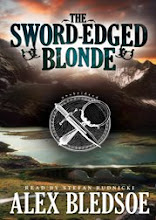
I remember watching The Maze at my uncle's house in Columbia, TN when I was a kid. I was too young for post-modern irony, so I took it at face value, and two things stayed with me: the nature of the monster at the end, and the "rational" explanation given for it.
Recently a friend found me a copy (it's never been "officially" released), and I was pleasantly surprised. The Maze is a low-budget little gem, full of surprisingly good things that balance out the...well, the undeniably goofy premise.
Kitty (Veronica Hurst) is engaged to Gerald (Richard Carlson), who is suddenly called back to his ancestral Scottish estate. Soon he breaks his engagement, but Kitty doesn't go down without a fight. With her spunky Aunt Edith in tow, she crashes Castle Craven and demands answers, especially when Gerald seems to have aged 20 years in a few weeks. When she doesn't get them, she sets out to find them on her own. What she turns up is...unexpected. WARNING: spoilers to follow.

Carlson, a veteran of It Came from Outer Space and Creature from the Black Lagoon, is adequately emo as the tortured Gerald, but Hurst is a surprisingly tough-minded and resourceful heroine. She never falters in her determination to help Gerald, even when he insists he doesn't need it. She isn't one of those easily frightened scream queens, so when she does finally shriek, it's for a good reason. She's a welcome relief from the distressed damsels of so many similar films.
The film was originally made in 3D, and the depth of composition is interesting even in a flat image. The weird framing device (Aunt Edith narrating as essentially a disembodied head at the bottom of the frame) might have made more sense in 3D. And the use of the titular maze is creepily effective, on a low-budget par with what Kubrick did in The Shining.
But nothing compares to the nature of the monster, or the villain, or whatever one would call Sir Roger, the Baronet McTeam. He is, in fact, a 200 year old, sentient, man-sized bullfrog.

Yep.
The film handles this in the only way possible, by keeping Sir Roger out of sight for most of the story, and almost gets away with quick glimpses during the climax. It's only the long shots, where the whole unfortunate costume is seen, and his rather silly demise that break out the giggles.
And much like the postscript of Psycho, we get a scientific explanation for what we've just seen. Seems that there was once an accepted theory called "phylogeny," which said that the human embryo goes through all the stages of evolution from invertebrate to mammal. Sir Roger, unfortunately, didn't develop past amphibian.
Sure, it's goofy. It was probably goofy in 1953. But it's also delightfully creepy, if you can put aside your post-modern irony.
Thanks to Bobbie at Junkyard Films for sending me this jewel.




















